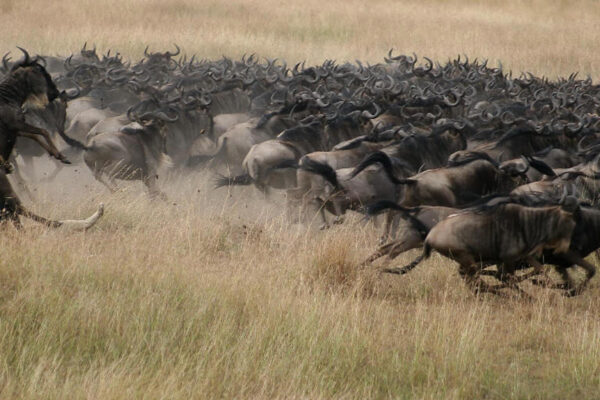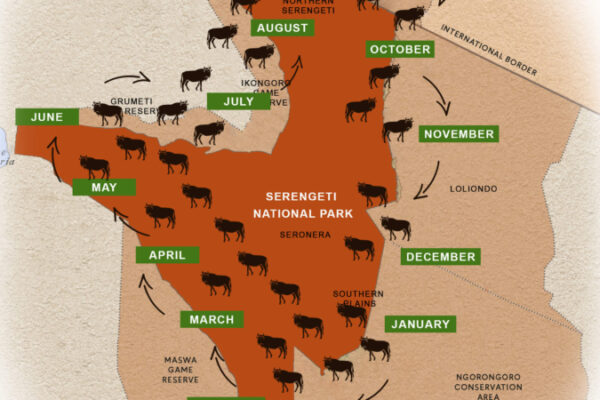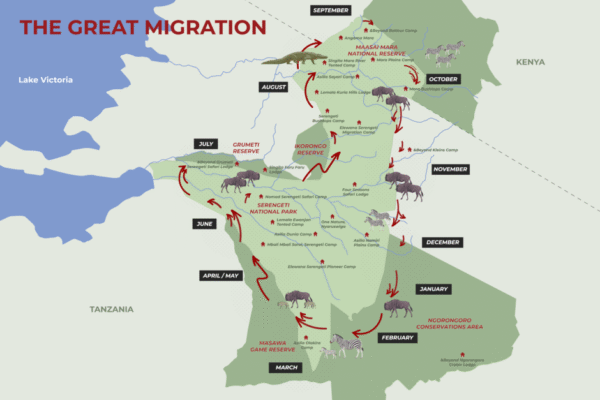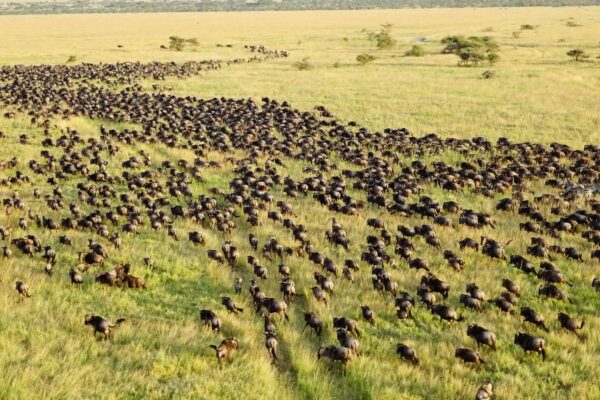Wildebeest Migration: Map, Distance, and Timeline (Visit Kenya or Tanzania)
The Great Wildebeest Migration (All You Need To Know Before You Go)
The great Wildebeest Migration: Map, Distance, and Timeline Visit Kenya (Masai Mara) or Tanzania (Serengeti). Explore Top Wildebeest Migration Facts in Africa.
The Great Wildebeest Migration is the planet’s most dramatic wildlife spectacle: over a million wildebeest (with zebras and gazelles) sweep across the Serengeti–Maasai Mara ecosystem in a rolling cycle of birth, hunger, and survival. Witness thunderous herds, predator action, and heart-stopping river crossings as animals follow the rains and fresh grasses, an elemental story of movement, timing, and raw nature that rewards any observer with cinematic scenes and lifelong memories.
Join a migration safari for wilderness-engaging days of game drives, expert guiding, and shocks of wildlife abundance, timed to catch calving in the south or the dramatic Mara River crossings in the north. Whether you want close-up herd dynamics, aerial perspectives, or luxury tented camps, the migration delivers headline moments and intimate encounters alike; plan seasonally, travel with experienced guides, and prepare for the unpredictable, the migration’s course follows the rains, not a calendar.
Wildebeest Migration Facts To Inspire You
The Great Wildebeest Migration is an annual, continent-scale movement of over a million wildebeest (with hundreds of thousands of zebras and gazelles) across the Serengeti–Maasai Mara, driven by seasonal rains and fresh grasses. The core circuit is often described as roughly 480 km (300 miles), though herd zig-zags and side excursions mean individual animals may travel many hundreds to over a thousand kilometres each year. The cycle peaks with January–March calving on the southern plains, a time of mass births, then a northwest push and the famous Mara River crossings (typical July–October). Those crossings, and attendant predator action from lions, crocodiles, and hyenas, create the migration’s most cinematic, high-stakes scenes and underline its role as a vital ecological spectacle.

Wildebeest Migration Map
The Great Wildebeest Migration traces a broad, roughly clockwise loop across the Serengeti–Maasai Mara ecosystem, shifting with rain and grass growth. Each year, the herds concentrate on the short-grass southern plains and Ndutu/Ngorongoro area for the January–March calving, then push west and northwest through the Serengeti’s western corridor (Grumeti region) before moving into the northern Serengeti and crossing into Kenya’s Maasai Mara in mid-year. After lingering in the Mara for the dry-season grazing and river-crossing spectacle, the herds eventually circle back south as rains return; the exact line on a map shifts year-to-year, but the same core areas repeat annually.

Wildebeest Migration Distance
Estimates of how far the migration travels vary because individual herds don’t follow a single fixed trail: National Geographic summarizes the commonly cited core loop as roughly 480 km (300 miles) annually for the principal circuit, but other measures that account for daily zig-zags, side excursions, and repeated back-and-forth movements put the total traversed ground much higher, some sources report 800 km (500 miles) or more, and when every local detour is counted the cumulative distance over the full cycle can exceed a thousand kilometres. Variation stems from changing rainfall, localized searches for water, and the herds’ shifting grazing strategy.

Wildebeest Migration Timeline
The migration is continuous year-round but concentrates into seasonal highlights driven by rains: January–March is the calving bonanza on the southern Serengeti/Ngorongoro (Ndutu), when thousands of calves are born; by late April–June the herds move through western Serengeti and the Grumeti area; July–October covers the famous northward push and Mara River crossings into Kenya’s Masai Mara (with prime river-crossing windows often in August–September); by November the herds begin the southward return as short rains restart and grazing improves in the southern plains. Exact timing shifts each year with rainfall patterns.

Kenya (Masai Mara) Wildebeest Migration Tours For 2026-2027
3-Day Mara River-Crossing Intensive Safari
Leave Nairobi (or fly to the Mara) for a compact, action-packed safari: arrive afternoon for an introductory game drive and overnight; dedicate Day 2 to full-day drives near the Mara River and conservancies to catch the crossings (guides stake out known crossing points); Day 3 offers a sunrise game drive or optional hot-air balloon before return. Best for travellers short on time who want focused migration viewing during July–October.
4-Day Balloon & Conservancy Experience
Combine river-crossing pursuit with a sunrise balloon, private-conservancy access, and off-track game drives: Day 1 arrive and overnight; Day 2 dawn balloon + guided drives into Mara North/Olare Motorogi for quieter crossing vantage points; Day 3 follow herd movements and photograph river action; Day 4 relaxed morning drive, cultural visit, and departure. The conservancy approach increases crossing chances and gives premium photographic positions away from the crowds.
7-Day Migration Photography & Deep-Track
Spend a week living with the migration: base in two camps (southern and northern Mara) to shadow herd shifts, include full days for dawn-to-dusk tracking, multiple river-crossing stakeouts, guided walking or community visits, and an option for a mobile fly-camp at a crossing hotspot. Longer stays let you time crossings, absorb predator scenes, and capture varied light, ideal for photographers and repeat-viewing seekers during the July–October peak.
Wildebeest Migration in Tanzania (Serengeti)
The Great Wildebeest Migration in Tanzania is a continent-scale wildlife phenomenon. About 1–1.5 million wildebeest, plus hundreds of thousands of zebras and gazelles, move in a vast, seasonal circuit across the Serengeti ecosystem, driven by rains and fresh grasses. Each year, the herd gathers for mass calving on the southern Serengeti/ Ndutu and Ngorongoro plains in January–March, then pushes west through Grumeti, north into the Serengeti, and across the Mara River (the famous, predator-filled crossings) around mid-year, before returning south as the rains shift. Mapped as a broad clockwise loop, the migration delivers cinematic river crossings, huge herds, and intense predator–prey interactions, making Tanzania’s Serengeti a must-visit for anyone seeking the planet’s most dramatic wildlife movement.
Tanzania (Serengeti) Wildebeest Migration Tours For 2026-2027
5-Day Calving Season Safari (Ndutu/Ngorongoro – Jan–Mar)
Witness the magical birth of over 400,000 calves on the southern Serengeti plains. Predators like lions and hyenas lurk nearby, creating dramatic action. This safari highlights the cycle of life with newborn wildebeest, predator–prey encounters, and sweeping grassland views. Ideal for photographers and nature lovers wanting intimate wildlife drama at its most raw and life-affirming stage.
6-Day Grumeti River Safari (Western Corridor – May–Jun)
Follow the herds as they surge through Serengeti’s western corridor, tackling crocodile-filled Grumeti River crossings. This safari showcases massive gatherings of wildebeest, zebras, and gazelles, paired with excellent predator sightings. Lodges and tented camps here offer front-row views with fewer crowds than the Mara crossings, making it a superb choice for adventurous travelers seeking exclusivity and authentic wildlife spectacle.
7-Day Mara River Crossing Safari (Northern Serengeti – Jul–Oct)
Experience the migration’s most iconic moment: dramatic crossings of the Mara River. Thousands of wildebeest plunge into crocodile-infested waters, creating unforgettable, high-stakes scenes. Game drives reveal predators, elephants, and giraffes sharing the savannah. This safari combines raw drama, diverse wildlife, and luxury camps in the northern Serengeti, delivering the quintessential Great Migration experience for travelers seeking bucket-list African adventures.
Let’s Help You Plan Your Wildebeest Migration Safari.
Embark on the ultimate Affordable Luxury Gorilla Trekking Safaris with Africa Gorilla Trek in Uganda, Rwanda, and Congo, where exclusivity meets adventure in the heart of Africa’s pristine rainforests. Our bespoke gorilla trekking itineraries provide intimate encounters with majestic mountain gorillas, guided by expert trackers in world-renowned parks such as Bwindi Impenetrable Forest, Volcanoes National Park, and Virunga National Park. Indulge in luxurious eco-lodges, personalized services, and seamless private transfers, ensuring a stress-free and unforgettable journey. Whether you seek short gorilla treks or Long, extended safaris, we craft tailor-made experiences that blend wildlife, culture, and relaxation. Book your exclusive Private Luxury African Safari today and discover the untamed beauty of Africa in unparalleled comfort!